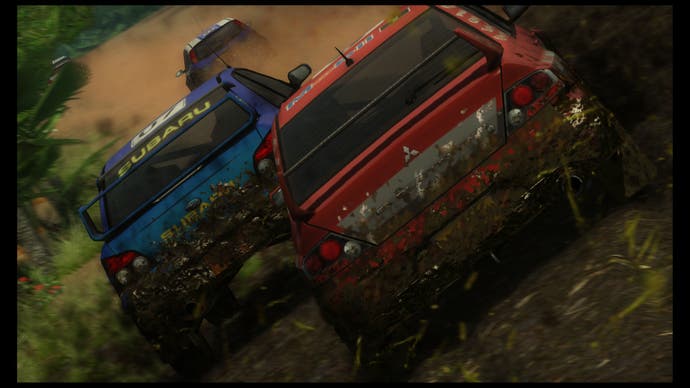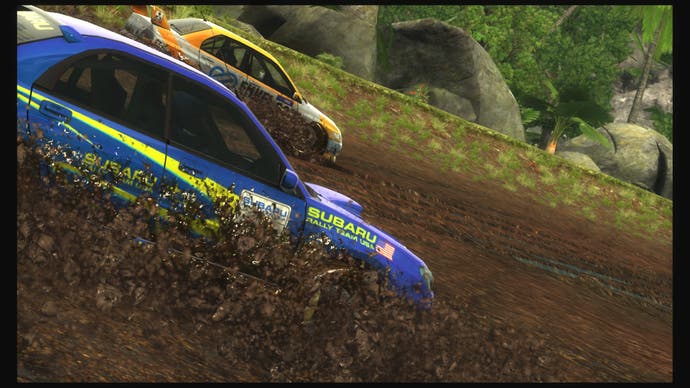SEGA Rally
Guy Wilday talks to us as we play SEGA Rally. A lot.
By spending about 40 minutes on each track, over and over, I'm able to refine what I'm doing to the degree that only the hairiest sections cause problems - a hairpin on the Canyon track, and sharp, muddy turns in the Tropical stages, for example. But the fun remains, and it's largely down to three things: the "Hollywood realism" handling model, the five other cars, and the surface deformation. When your opposition's human, it can be hair-raising. Adjusting your position on the track is rarely easy; loose-surface racing has always emphasised that, and when your opponent ahead clips the inside on a set of very long opposing turns in an attempt to ride through them in near-enough a straight line, his desperate attempt to hold momentum while he fishtails left and right is going to cause you problems. If you smack into him, who knows to what extent? There's no damage modelling in the game (it wouldn't be very SEGA Rally), but getting stopped hurts.
Playing against the AI isn't so different. "One of the key things is that they've got to adapt to what's happening with the track; the track's changing, you're having to drive differently because of that, and they're going to have to do exactly the same thing," Wilday observes. "We've got a fairly sophisticated AI system that is adapting to how the race is changing." In practice they have a tendency to roar off at the start and then need to be pegged back while you're getting to grips (apologies) with the surface. But they pay their AI colleagues the same sort of attention you might expect to see reserved for you; on one occasion I entered a tunnel glancing nervously at a Peugeot and a SKODA in my rear-view, and upon exiting they were both gone - victims of a tightening bend and their own mutual stubbornness. Even over the course of a few hours it's hard to confirm Wilday's comments about their adaptiveness, but they certainly put up a good fight.
Which, when you put it in the context of my rising stock, ought to suggest they are as he says. By hour three I'm good enough to win most, if not all the races I start. The skill is in adjusting without overcorrecting, powersliding efficiently, staying out of the way of other racers, and - as SEGA Racing Studio hoped would be the case - mastering the way the surface changes. Some of it's laid out when you start - ruts through snow and mud point to the racing line - and these are then augmented on laps two and three as further ruts are born and harden under the sun. Riding across them subsequently is like driving over a rumble strip.

Wilday says his goal for each environment is "basically to have extremes of surfaces and extremes of gameplay"; for them to be characteristic both in terms of the make-up of their surfaces and the distribution and transitions between them, as well as aesthetically. There's plenty of evidence of that already: Alpine's gradual ascent into slush and then snow forces you to brake sooner, reconsider the apex and be more mindful of those around you; and probably the most satisfying part of the entire game can be found in Canyon, as you powerslide through a 90-degree right-hander that leads onto a bridge and the dust transitions to tarmac, with the sudden burst of friction wrenching you forward and saving you from crashing into the barrier. It makes me smile every time.
The sense is that SEGA's approach to the Western market is actually the sort of approach that Japanese companies are now taking: to treat the world as a single market, and design games with broader appeal. Wilday admits that gamers seem to want tighter games these days. Their reaction, on the evidence of our hours with SEGA Rally, is a game that concentrates a greater density of content into a smaller package, boring layers of potential into each track that you're able to unlock as you graduate from slippery idiot to confident driver to rally supremo. I've hardly exhausted each track either - I've not had a chance to experiment with the difference it makes using Road tyre settings over Rally; I've not mastered hairpins; I've only seen one class of car; I've not even had a chance to test all my ideas.

One of these is that as you're approaching a corner with a racing line in mind, and you see an area that's off the optimal line but well worn, you might almost do better by following that instead, such is the speed benefit you get from following the deformed areas. "Obviously taking a shorter line is the shortest route round the corner, but you're absolutely right - if it's not a worn part of the track you're not going to get much grip and traction and therefore speed, so there is a trade-off there," says Wilday. In other words, churning sand on the optimal line may be no better than braking harder on the worn one. "Yep, it may be evens - it may be that a shorter line on a less worn piece of track will work out exactly the same as a more worn line. That's almost like a driver choice as you go around - you can decide which path you want to take. And again, it might be determined by whether there's a car around you."
As you've gathered, it left us very upbeat as we exited Blythe Business Park at the end of the day. We wanted to see more. We wanted to see the other environments (they won't tell us what they are, but we spot "Coastal" and "Arctic" mood-boards lying around the studio), we wanted to check out the other car classes (there'll be more than 30 vehicles - including "Classic" and "Bonus" ones, with new liveries unlocked by accumulating mileage), and of course we wanted to go online. Both PS3 and 360 will offer 6-player competitive racing, with Time Attack as mentioned and downloadable ghosts to go with each leaderboard. In fact, Wilday says the two versions are identical in every respect, and they seem to be. The Xbox 360 version might end up with PC-Xbox cross-play on Vista ("I'm not sure that's going to make it in. We'll see."), but apart from that and the lack of rumble in the PS3 pad, "you'd be hard-pushed to tell them apart". So that's nice then, and in deference to the developer, the best way to celebrate this seems to be downing tools and heading off to the Quack & Pheasant.
SEGA Rally is due out on PlayStation 3, Xbox 360, PC, PSP and mobile this September, or thereabouts.


.png?width=291&height=164&fit=crop&quality=80&format=jpg&auto=webp)




.jpg?width=291&height=164&fit=crop&quality=80&format=jpg&auto=webp)
